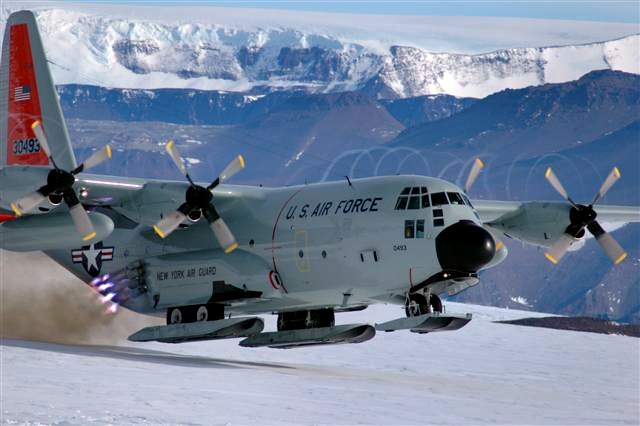|
Ice rescueUSAP helps evacuate injured worker from Australian Antarctic basePosted November 7, 2008
A complicated international air operation coordinated by the U.S. Antarctic Program (USAP) The patient arrived in Tasmania just before midnight local time on Nov. 5, after a roughly 10-hour flight from Australia’s Davis Station A ski-equipped LC-130 Hercules transport plane left McMurdo Station Press Releases
The turbo-prop Hercules picked up the injured person, who Australian authorities described as in “serious but stable” condition, for the flight to Tasmania. The “Herc” was flown by the 109th Airlift Wing of the New York Air National Guard A combined U.S. and Australian medical team was on board the aircraft to assist in the evacuation. The team consisted of an Australian doctor and nurse; a Joint Medical Attendant Transport Team consisting of three U.S. Army medical personnel from Tripler Army Medical Center The medical team, along with aircrew members and an aircraft maintenance team, spent the night at Davis Station in order to rest, allow the aircraft to re-fuel and to help prepare the patient before beginning the flight to Hobart. The aircraft landed on a temporary runway at Davis that had been prepared by station personnel over the past week. The sea-ice runway is 3,000 meters long on ice 1.8 meters thick. Certifying that the runway was capable of safely handling the aircraft – which weighs roughly 68,000 kilograms fully fueled – required extensive collaboration among NSF, the U.S. Air Force and AAD. The landing at Davis Station was a first for the Guard. The successful operation was a tribute to their skills and to those who made sure that the unusual landing could be made safely, said Karl A. Erb, who heads the USAP. “I commend the aircrew and all the personnel, both military and civilian, who ensured this safe and successful flight under these difficult and unfamiliar conditions,” he added. After careful consideration of the options for safeguarding the patient’s health, AAD had formally requested assistance from the USAP in October. Erb noted that while the medical mission was possibly unique in the history of exploration of Antarctica due to the many unknowns involved, the cooperation among nations who maintain a scientific presence there was not. “We … recognize that even in the days of routine flights and the ability to supply most of life’s creature comforts at the bottom of the world, that prying scientific secrets from this beautiful but hazardous place is not without risk,” he said. “Each national program stands ready to help any other whenever possible in cases like this. I speak for all of us in the U.S. Antarctic Program when I say that we are glad to be able to make a contribution, both to the individual’s safety, and to the collective good.” Tony Press, AAD director, said he was very grateful for the support provided by NSF. “It has enabled a quicker and more stable evacuation option than Australia’s research and resupply ship Aurora Australis “It’s a tribute to our excellent relationship with the U.S. Antarctic Program and a fantastic example of the collaboration that typifies Antarctic operations.” |



For USAP Participants |
For The Public |
For Researchers and EducatorsContact UsU.S. National Science FoundationOffice of Polar Programs Geosciences Directorate 2415 Eisenhower Avenue, Suite W7100 Alexandria, VA 22314 Sign up for the NSF Office of Polar Programs newsletter and events. Feedback Form |


